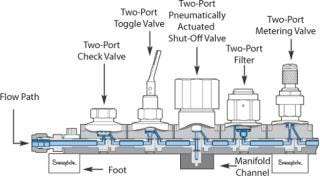Take the Laboratory to the Sample: Implementing PAT with Miniature Modular Technology
July 1, 2008

Figure 1.
The pharmaceutical industry has relied on laboratory testing for all of the past century. Typically, biopharmaceuticals are manufactured in batches and tested for quality using off-line laboratory test methods of samples extracted from the process line.
However, taking the laboratory to the sample changes the way analyses are conducted. The FDA Guidance for industry, PAT: A Framework for Innovative Pharmaceutical Development, Manufacturing, and Quality Assurance, promulgated in final form in September 2004, encourages the use of available process analytical tools to support innovation and efficiency in biopharmaceutical processing. The intent of the guidance is to describe a scientific, risk-based regulatory framework to support innovation and efficiency in biopharmaceutical development, manufacturing, and quality assurance. The PAT framework is a system for designing, analyzing, and controlling biopharmaceutical manufacturing through timely measurements of critical quality and performance attributes of raw and in-process materials and processes to ensure final product quality.
The New Sampling/Sensor initiative (NeSSI) was released by the Center for Process Analytical Chemistry (CPAC) at the University of Washington in August 2000. CPAC stated that the initiative was “…an effort to facilitate the state-of-the-art evaluation (and ongoing development) of the next generation of modular sampling systems.”
NeSSI Generation I, the mechanical embodiment of a miniature modular system, proved the feasibility and practicality of miniaturized sampling systems. Generation II, the embodiment of automated systems populated with intelligent devices that communicate through an open architecture communications bus, will take these systems to the next level of enabling capability. Generation III is envisioned to be populated with microanalytical devices, to operate intrinsically safely, and to use wireless communication.Figure 1

Figure 1. ()
MPC: A Solid Platform
Miniature modular platform technology provides the means to build and install compact sampling systems, sensor arrays, and complete miniature process analyzer systems. Combining process analytical technology (PAT) with miniature modular platform technology allows analyses to be made at the process line with results made available immediately.
Modular platform technology may be used in many applications, concentrated in three areas: laboratories, pilot plants, and process plants.
In the laboratory, bench space is always at a premium. A miniature modular system frees up space and reduces clutter. NeSSI systems are easy to develop, assemble, and install. A modular system can also assist in the mixing and distribution of laboratory gases.
In pilot plants, personnel safety, cost, and space are issues as well. In the biopharmaceutical industry, the lengthy scale-up process begins in small reactors on a lab bench, is followed by manufacturing scale-up and process design, and finally reaches the larger-scale pilot plants that produce product for clinical testing.
In process plants, continuous on-line analyses require networked systems capable of making multiple measurements at multiple points. There are numerous points where clusters of sensors installed on a modular platform can make multiple measurements.
The Pat initiative specifically recommends an increasing use of at-line, on-line, and in-line analyses, as well as the current offline methods. Modular platforms may be used in all of these categories of analysis.
You May Also Like





